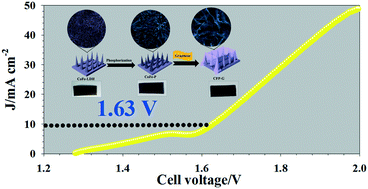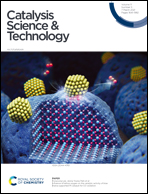Formation of graphene encapsulated cobalt–iron phosphide nanoneedles as an attractive electrocatalyst for overall water splitting†
Abstract
The rational design of stable, low cost, and earth-abundant electrocatalysts with advanced compositional and structural superiority is very desirable for water splitting. As an inexpensive and helpful class of materials, metal phosphide (MP) nanostructures present promising applications in water splitting. Herein, a helpful binder-free electrocatalyst derived from CoFe–P nanoneedles encapsulated in a graphene texture on nickel foam (NF) (denoted CFP-G@NF) was rationally fabricated. Such an innovative architecture effectively maximized interfacial contact and conductive properties to enhance charge-mass transfer, boosting the catalytic performance and stability towards the hydrogen evolution reaction (HER) and the oxygen evolution reaction (OER). CFP-G@NF exhibits reasonable performance for the HER (small overpotentials of 71, 64, and 161 mV in alkaline, acidic, and neutral solutions at 10 mA cm−2) and the OER in alkaline solution (an overpotential of 400 mV at 60 mA cm−2). Besides, the assembled CFP-G@NF||CFPG@NF water splitting cell reveals a current density of 10 mA cm−2 at a cell voltage of 1.63 V. Most significantly, the encapsulation of graphene texture prevents CoFe–P nanoneedles from corrosion, indicating good durability after 24 h operation.



 Please wait while we load your content...
Please wait while we load your content...